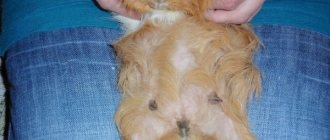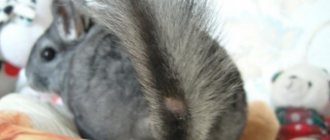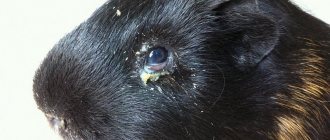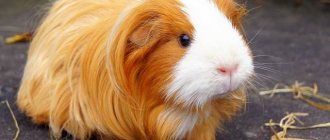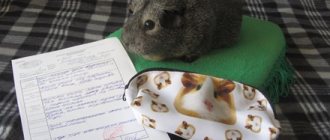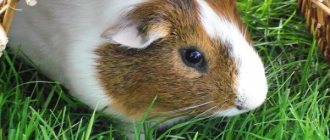- home
- Guinea pig
- Guinea pig health
02/14/2019 Every animal owner is faced with the phenomenon of shedding. It is important to distinguish between natural hair loss and a symptom of disease. If the owner knows when guinea pigs shed and what causes this process, he will be able to take care of his pet and provide him with the necessary help. Please remember that the information offered is not a substitute for visiting a veterinarian who has the resources to make an accurate diagnosis.
Causes of hair loss
Hair loss in guinea pigs is caused by the following reasons:
- Lack of vitamins C and B. Often occurs in winter, due to the limited amount of fresh fruits and vegetables.
- Stress: Causes hair dullness, hair loss, and gray hair. Caused by various reasons - moving, the appearance of new people or animals, loud sounds and other factors.
- Allergy.
- Fungus. The most dangerous is ringworm.
- Skin parasites: fleas, ticks, lice, lice.
In addition, the cause of local hair loss is physical trauma - a burn (including chemical), cut or bruise. After the wound heals, the fur will grow back on its own.
New growths on the skin
Tumors in guinea pigs are rare, but, of course, sometimes it is the neoplasm that causes a visit to the veterinary clinic.
What could it be?
As a rule, the owner may suspect a tumor in his guinea pig if he notices a strange lump on the pet’s body or a non-healing wound. However, the neoplasm is not always malignant. This may be an abscess - a purulent capsule resulting from an injury. A lipoma, a benign formation consisting of fat cells, can also develop on the body of a guinea pig. Lipoma grows slowly and does not pose a threat to the pet’s life; it looks like a lump with moving contents.
In principle, a benign tumor can be distinguished by its growth rate and structure. The benign formation grows slowly and is located, as it were, on a stalk, at some distance from the skin. Cancer most often looks like an unhealed wound rather than a lump. It affects the skin on the paws, less often on the back or sides.
Treatment
To treat an abscess, Vishnevsky or Ichthyol ointments are used. They contribute to the rapid “ripening” of a purulent wound, which, after opening, is cleaned of pus and disinfected. Tumors, of course, need to be removed surgically. Moreover, it is also advisable to remove a benign lipoma, because there is always a risk that it will develop into a malignant liposarcoma. With timely surgical intervention, 70% of cases result in a complete cure.
Shedding without pathology
Guinea pigs molt in spring and fall. In September, the pet’s body tolerates it without interference, since the summer diet is full of fresh herbs and vegetables. Spring molting occurs in February and requires vitamin supplements in the diet. In addition, juvenile molting occurs in young individuals - a change from “childish” hair to “adult” hair. It is one-time and will not be repeated.
At home, the temperature in the apartment does not change significantly, so the pigs constantly shed a small amount of hair. If the process is not accompanied by alarming symptoms, such prolapse is safe. With age, wool grows in greater quantities. This is due to changes in the body. In addition, older animals spend less time caring for their fur.
Gilts are characterized by “bare” areas of skin behind the ears, provided that there are no peeling or wounds in these areas.
Video “Cutting a guinea pig’s claws”
To ensure that your pet pig does not have pododermatitis, you should trim its claws on time, and the video will further demonstrate how to do this.
Sorry, there are no surveys available at this time.
Was this article helpful?
Thank you for your opinion!
The article was useful. Please share the information with your friends.
Yes (100.00%)
No
X
Please write what is wrong and leave recommendations on the article
Cancel reply
Rate the benefit of the article: Rate the author ( 5 votes, average: 4.80 out of 5)
Discuss the article:
Lack of vitamins
Lack of vitamins is a relatively painless reason why your guinea pig sheds. In addition to baldness, there are no other unusual symptoms: the animal is active, has a good appetite, does not itch, and there are no redness or wounds on the body. For treatment, fresh vegetables and herbs are added to the diet: dill, parsley, carrots. Regular hay is replaced with clover or legume hay. Additionally, ascorbic acid is added to drinking water (20 mg per day is enough). Pet stores sell special complexes of microelements - calcium, phosphorus, vitamin C. Particular attention should be paid to the pet during seasonal molting and immediately after pregnancy, when the animal’s body is weakened.
It is not recommended to leave vitamin deficiency without treatment: the pet’s immune system weakens, which opens access to dangerous infections in the body.
When to be wary
When a guinea pig makes strange noises, it can mean both positive and negative emotions. You need to study the character of the pet, see what happens to it
A screaming guinea pig tries to attract the attention of its owner. The animal has problems and there is no other way to convey it
Sounds that are alarming:
- The pet squeaks loudly. If there is no one nearby, the paw is not stuck, and no other visible causes are found, the animal must be urgently taken to a veterinary clinic.
- An animal that can hear wheezing when breathing needs urgent medical attention.
- The animal is shown to the veterinarian when teeth grinding is heard. There may be serious dental problems that need to be addressed.
- The cry of a pet signals that he is uncomfortable and scared. The animal is cold or, on the contrary, hot, its stomach hurts, there has been no water in the drinking bowl for a long time, it is tormented by thirst.
Each pet is individual. There are pigs who violently express emotions, squealing with joy at every occasion. Others may rumble quietly in the same situation. The owner’s task is to listen to the sounds the animal makes. If you are attentive, you can recognize what your pet’s mood is and what it wants.
In this article, I will describe the possible reasons for a guinea pig squeaking loudly when you try to pick it up or pet it, why its teeth chatter and squeak when you pet it. Often, inexperienced owners are frightened by the sounds made by the animal, believing that the pig is sick with something. In fact, the animal communicates its needs and emotions to humans.
Fungal diseases
The most common infections in pigs are lichen and dermatophytes. Symptoms of lichen:
- hair falls out in clumps;
- itching;
- skin redness;
- purulent wounds (in later stages);
- dandruff appears.
Ringworm is contagious to people and animals. If this disease is detected in the room, a wet cleaning is carried out and the cage and all objects used by the pet are disinfected.
With ringworm, the animal's skin peels off and bald spots appear on the head. Over time, the disease spreads to the neck, paws and other parts of the body. Infection occurs through low-quality food or items brought from the street. The infection is often “brought” into the house on shoes or clothing.
Nizoral shampoo is suitable for treatment. In just a few procedures, it removes itching and inflammation. Apply it to sore spots for 5-7 minutes, then wash off with warm water. It is not recommended to bathe a pig entirely - they do not like water treatments. You can also use Fungoterbin and Thermikon creams (one percent). As a last resort, you can purchase Castellani or Fukortsin.
Trixacarosis
The disease is caused by mites that infect the inner layers of the skin. Symptoms of infection are rough skin, baldness, redness and dry crusts. If treatment is not carried out at the initial stage, then purulent painful ulcers form at the site of redness. The disease is accompanied by severe itching. The animal becomes restless, the temperature may rise and loss of appetite may occur. The disease is diagnosed exclusively by skin scraping. Treatment depends on the stage of the disease.
Demodicosis
Demodicosis is very similar to the previous disease and is caused by mites that parasitize the inner layers of the skin.
Purulent ulcers form at the site of the lesion. During the illness, the guinea pig sheds heavily, refuses to eat, and has an increase in body temperature and anxiety. If treatment is not started in time, the guinea pig may die from exhaustion. Demodicosis is dangerous because it can be transmitted to humans. Handle an infected animal only while wearing gloves. The disease is diagnosed by skin scraping in a veterinary clinic.
A sick guinea pig should be immediately isolated from other animals, and the cage should be washed with a chlorine-containing solution. All animals in contact with the sick person should be treated with a special antiparasitic shampoo. Treatment includes the use of antibiotics, shampoos, healing ointments and compresses.
lice eaters
Lice eaters are tiny insects that closely resemble common lice, but are smaller in size. Lice eaters can live in dirty litter and are transmitted through animal contact. Typically, lice eaters affect the perineal area, muzzle, withers, ears and tummy. You can also see them with a regular magnifying glass - they look like small white moving dots on the animal’s fur. The first symptom is severe itching. What to do if you have lice eaters?
The first is to isolate the animal and wash the entire cage with a special Frontline shampoo or chlorine-containing solution, and then spray the cage with an anti-lice spray. An infected animal should be treated with Acaromectin, Bolfo or Bars spray. Some breeders note a good effect from flea drops Advocate for kittens. However, you should be careful with these drops and use them strictly in accordance with the weight of the animal. For an adult and well-fed pig, 0.1 ml of drops per kilogram of weight is required.
Diseases caused by skin parasites
Sometimes skin parasites penetrate the fur, causing guinea pigs to shed. Common causes of parasites:
- poor quality feed or hay;
- dirty bedding;
- appearance of infected animals;
- walking through dirty places on the street.
Cats are usually carriers of fleas. Fleas cause severe itching, and the pig scratches itself until there are bloody wounds, which are dangerous because they open up access to infections. If fleas are found, treat the pet and cage with cat shampoo. After two weeks, the procedure is repeated for prevention. The premises should also be disinfected.
Skin mites settle under the pet's skin, which they feed on. The parasites cause severe itching, which causes the guinea pig's hair to fall out. The animal constantly itches, loses sleep and appetite, which eventually leads to exhaustion and death. For treatment, subcutaneous injections of Ivermectin are used. The dosage is measured according to the instructions or as directed by the doctor.
Skin parasites can be seen with a magnifying glass. To accurately determine the disease, the pet is taken to a veterinarian, who will conduct the necessary tests and prescribe a course of treatment.
Why does it itch?
The owners of some guinea pigs notice that their pets not only shed a lot of hair, but also itch at the same time. There are cases when the itching is so severe that the animal seriously injures itself.
Causes
Itching in a guinea pig is almost always caused by the activity of ectoparasites; lichen causes itching extremely rarely. At the same time, fleas, lice, ticks, and lice-eaters can parasitize a piglet’s body. A cat flea can also spread to a guinea pig if this pet also lives in your house. Fleas cause severe itching, and crusts may form on scratched areas. With a large number of parasites, anemia may develop.
The most common parasite found in guinea pigs is the Trixacarus mite, otherwise known as the itch mite. The parasite lives up to its name by causing severe, incessant itching. Crusts, scabs, sores, and redness appear at the bite sites. Bacteria can enter wounds, causing severe suppuration and infection. The pig becomes very restless, loses weight, and if there are a large number of parasites, it can twitch convulsively and throw itself at the cage.
Treatment
Before treating mumps, it is necessary to confirm the diagnosis using scrapings. Ivermectin is used to treat mites in guinea pigs. The dosage and number of injections are prescribed by a veterinarian familiar with guinea pigs and the dosages applied to them. Also, to destroy ectoparasites, you can use cat and dog insecticides, in particular, Stronghold drops on the withers for kittens.
Baldness caused by stress and allergies
Stress causes hair loss in pigs. Small animals are shy, so various factors serve as a source of concern:
- noise;
- moving;
- change of feed;
- the appearance of new people or animals;
- prolonged contact with a person.
To calm the animal, it is placed in a quiet, isolated place. Add more juicy foods and greens to the diet. Usually improvement occurs soon.
The allergy is manifested by sneezing and watery eyes. But sometimes it becomes the reason why a guinea pig’s hair falls out on its butt, sides or back. To eliminate symptoms, it is enough to identify the allergen and isolate your pet from it. To do this, the animal is replaced in turn with food or bedding material.
Pododermatitis
Pododermatitis is a fairly common condition among rodents, characterized by a disease of the paws and otherwise known as “painful heels.” Most often, the disease affects the guinea pig's hind limbs and hock joint.
Causes
The following factors contribute to the development of pododermatitis:
- Inappropriate conditions for keeping a piglet. Dampness and dirty litter are favorable soil for the proliferation of pathogenic bacteria.
- Excess weight of the pet, it puts additional stress on the paws.
- Low physical activity of the pig.
- Uneven, wire floor in the cage. If every step causes deformation of the animal's foot, it is likely to develop pododermatitis.
- Lack of certain vitamins, in particular vitamin C.
- Claws cut at the wrong time.
An animal affected by pododermatitis will bend its legs and become limited in its movements. Hair falls out on the affected limb, swelling and redness occur.
Then, without appropriate treatment, ulcers and wounds appear on the paw, the animal becomes lethargic and apathetic, and may even cry.
Treatment
It is very important to prevent the development of pododermatitis. That’s why clean the cage on time, use soft material for filler that will not injure your pet’s paws, and trim overgrown claws in a timely manner. If it does develop into pododermatitis, be prepared that it will take quite a long time to treat it. The wounds on the paws are first treated with solutions of chlorhexidine or hydrogen peroxide.
Then Levomekol or Solcoseryl ointment is applied. Antibiotic therapy is sometimes required if the wounds are severe and threaten to develop into blood poisoning. In severe cases, an x-ray may be necessary to ensure the bone is intact.
Symptoms
The disease often begins in the head. The pet scratches its ears, spots appear in areas where there is the least fur. There it is easier for mites to get to the skin. Peeling and a thin crust appear along the edges of the ears.
Gradually there are more spots. The infection spreads to the face. Next they are amazed:
- muzzle;
- elbows;
- hock joints;
- rib cage;
- belly, etc.
Red itchy dots gradually give way to nodules. They fill with liquid and burst, forming scabs, scabs, cracks, and erosions. Over time, the dog becomes bald, the skin thickens, and continues to itch. The pet itches a lot and gnaws the skin. Females rest during the day, so exacerbations occur at night.
Treatment of otodectosis
To kill ticks, Oridermil (France) is prescribed - one of the best drugs for treating cats and dogs with otodectosis. The ointment copes well not only with mites, but also with bacteria, fungi, and relieves inflammation. Side effects are rare. Contraindications include perforation of the eardrum, pregnancy, lactation, and allergies. The only negative is that ticks develop resistance, so the product cannot be used for more than 10 days in a row.
